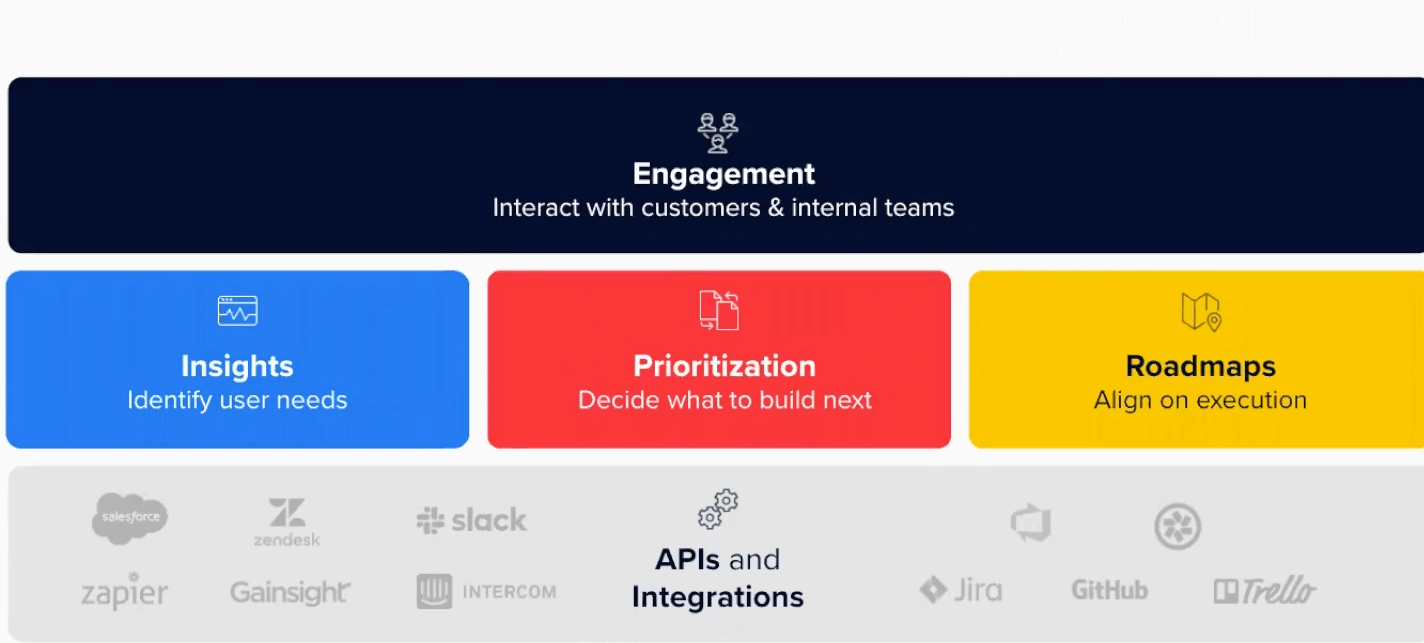My name is Cindy Berman, Product Marketing Manager at Productboard.
Pricing and packaging can be a mystery for high-growth startups, and successfully cracking the code can be a real headache!
But don't worry, because in this article, I’m going to break down the many pitfalls into 10 common mistakes. I hope after reading, you'll be able to spot these mistakes early, and this will help you to execute pricing and packaging with realistic goals that are deliverable.
On top of that, here are some of the key talking points I'll be covering:
- Creating a compelling and high converting pricing page.
- Incorporating lessons and best practices on content structure and format.
- How to effectively collaborate with and enable internal teams for a successful launch.
- How you can use your pricing page to demonstrate your product's value and customer benefits.
A bit of background on Productboard
In October of 2020, after months of research and evaluation of our existing pricing and packaging, Productboard updated our pricing and packaging. To give you some context, I'll take a step back and start by sharing some information about Productboard.
Productboard is the first customer-driven product management system. Productboard helps product managers at thousands of companies like Microsoft, Zendesk, and UI path, understand what users need, prioritize what to build next, and rally everyone around the roadmap.
You can think of Productboard as a CRM for product managers, helping you build excellent products for your customers. As a high-growth startup backed by investors, there comes a point in every company where you need to revisit your pricing and packaging.
Your previous pricing and packaging may have been super successful in the past, but as you scale and grow your company and customers, it's crucial to reassess them. Also, your vision of success and how you measure a vision of success changes.
Productboard’s product management system

You've achieved Product Marketing fit, and are looking to gain market share with new customers.
This is a perfect time to take a step back, take a deep breath, and think about:
- What's working?
- What can be improved?
- What should be changed?
- Which plans are prospects choosing?
- Are customers seeing the value of the plan?
- Is the plan meeting their needs?
- Are customers frequently switching from one plan to another?
You can also think back to quarterly business reviews or conversations your success managers have had with customers. What features are customers and prospects constantly requesting that are not available on your existing package.

Pricing
As businesses seek to drive revenue and profit, are your prospects and customers sharing that your product is too expensive to satisfy their needs?
Do you even see customers turning for cheaper competitors, or even prospects going to cheaper competitors? Or, on the flip side, does your product actually give away too many features and functionality? Well, you may be providing customers with more value than the price should necessitate.
In this case, you can revisit increasing your pricing. This is dependent on customers being willing to pay, of course. Or you can decrease the features and value you provide in your existing plans. That way, you're providing less value, but for the optimal price. The value matches the price.
So, now it's time for me to share 10 Common Mistakes high growth startups should avoid and how to avoid them so that you can execute pricing and packaging effectively.
1. Relying on assumptions while forgetting data and customers
One of the biggest challenges I see SaaS businesses facing with pricing and packaging is not creating a data-driven strategy, not understanding the customer, and not bringing the customer's needs into their strategy.
Practice what you preach
At Productboard, we practice what we preach. We make decisions based on data and customers, not just assumptions. Before defining a pricing strategy, you must understand your customers and target audiences.
This will enable you to best market your product and its value to them. You can use a customer-driven product management system like Productboard to capture and organize customer internal and even prospect feedback, into a single product repository.
Analyzing this information, you can quantitatively determine the following: what are the research reasons your customers have chosen your product and company? Why have they chosen competitors instead?
Do your products meet customer needs?
Think of the personas work you've done. Personas are a representation of your ideal customer per customer. It's crucial to ensure each package you create is mapped to a persona or multiple personas, their needs, and their willingness to pay.
If your packages don't solve their needs, you won't be able to successfully sell to your target audiences, hurting your sales efforts. You should also execute an in-depth analysis.
Doing so enables you to determine how to best show your product value and benefits to customers. You can identify gaps and opportunities you may have in packaging your product and communicating its value.
Are you looking at the bigger picture?
For example, during Productboard's research, we determined that there's a segment of customers that are focused on just building the best product roadmaps. They weren’t looking at the bigger picture. There are other jobs to be utilized, such as incorporating customer feedback and using software and insights for feature prioritization planning.
Look at the data
Productboard took this customer insight and used it to repackage our product, creating an affordable and easy-to-start first plan.
Keep in mind, it's not always crucial to recreate the wheel and completely update or even overthrow your pricing and packaging. By looking at your data, you can see trends on what's working and what’s resonating with customers.
You can also analyze the performance of your existing pricing page as a method to understand prospect interest and intent through interaction. With Google Analytics, you can see on your pricing page, which links your prospects are clicking on most frequently.
You can see how often they read your detailed feature comparison chart, what parts of the page are most interesting, and what frequently asked questions most closely resonate with them.

Don’t skew the data
When executing this analysis, it's important to segment new users from existing customers or employees for accurate metrics. Once you're thinking about updating your pricing page, or once you've done it, you'll likely have many views daily from existing and existing employees, which would ultimately skew your data.
2. Failing to understand your competitors
Having an in-depth understanding and analysis of your competitors is crucial. Some of the questions you should be asking are:
- What are the existing solutions that your customers may be looking to replace?
- What are their strengths and weaknesses?
- What types of customers and industries are they more likely to capture?
- What are the problems your customers and prospects identified that your competitors aren't solving?
Look at your competitors
On the last point, you can read Jeetu and Capterra reviews to better understand the strengths and weaknesses of your competitors, and why customers choose to buy their products or leave them.
You can also use Salesforce competitive data to ensure your sales team records competitors that prospects are evaluating. These competitive insights really guide packaging decisions.
3. Not understanding where your product fits in the market
Is it disrupting an existing market? Or is it creating a new one? At Productboard, we understand now's the time for product management. We call it:
The golden age of product management
Product management roles in the US have grown by an astounding 32%!
But despite the growing importance of product management, there really hasn't been a dedicated system for product teams to ensure they're building the right products for the right audiences.
Salespeople have Salesforce and marketers have Marketo. But product managers have traditionally used an assortment of PowerPoint, email, post-it notes, Slack, Excel, and many other generic task management and engineering tools that are not really up to the job.
Customer-driven product management
Here we get into the fallacy of thinking your pricing page is only about conversion, not education. Productboard, like many other products, is creating a new category. It's flexible, comprehensive, and built on an open platform to meet the needs of today's product organizations. 👏
Here, you'll be able to provide more guidance regarding the value of your product on your existing pricing page.
Through this method, your pricing page serves two purposes.
- Conversion for paid plan or trial signups
- Awareness and education about your products.
It doesn't mean that when a prospect automatically comes to your pricing page, they'll sign up. Marketing and acquiring potential customers takes time.
You also cannot assume that even though the user came to your website, they understand what you do fully, and the value you can provide them to solve their biggest needs and pain points. Once again, you need to put yourself in the mind of the customer.
Put yourself in their shoes
A helpful trick to do so is to think back to the first day of your company. What information did you know about the company? How did the pricing page share with you what each plan was offering?
Think back to the basics. What information was clear and easy for you to comprehend? And what information did you not understand or was missing?
As you seek to create a new category, it's crucial to simplify your message, but at the same time, highlight the most important features and value you provide to customers to solve their needs.
On the other hand, if you're looking to disrupt an existing category, you can focus on product differentiation via new features.
You don't need to spend time on your pricing and packaging to educate and convince customers why they need your type of software to solve their needs. Instead, you need to focus on how your software is better than the existing software.
4. Not understanding how crucial your pricing page is
Think of your pricing page as the epitome of your pricing and packaging efforts. Your prospects will not read pages and pages of Docs. Instead…

Keep it simple
They want an easy way to understand how each plan serves their needs and can solve their problems. Guide them through the decision-making process so they can buy their software, but then get back to focusing on their everyday job. You may also assume incorrectly that more is better.
More information, more copy, more context, more features shared is better. Not always.
While many people, especially in Western societies, are conditioned to believe that more choice is better, the opposite is often true. Too much choice, such as seeing 15 features listed in one plan versus 18 features, actually causes less satisfaction. You risk overwhelming your customers.
Keep it manageable
Instead, I advocate for concision. Or in this case, SaaS companies communicate a manageable amount of product information, so your customer finds something that meets their standards, which of course, can be high.
5. Failing to focus on user experiences and leveraging best practices
During my pricing research, I created a cohort of 21 high-growth B2B SaaS companies. I wanted to understand how they market their product and determine best practices for pricing.
Some of the companies included Slack, Mixpanel, Marketo, and Segment. I focused on understanding user experience and converting that into growth.
User experience is everything
Live it and breathe it. Get your whole company on board. Put yourself in the shoes of your prospects and their software experience.
You can use your own cohort of SaaS companies to use or test their pricing pages and offerings. Think of it as your user testing some of your favorite or most highly admired product’s pricing pages. Whether you're a customer right now, or a prospect, you can better understand the optimal user experience you desire for your own pricing page.
You will be able to review key design aspects, formatting key components such as product demos, number features, frequently asked questions, support, and success offerings, which will guide your own pricing page decisions. You can think to yourself, what works? What could be easier and what information or functionality is missing?
Are you able to easily pick which plan best suits your needs? Doing so provides a holistic view of all the key components you may decide to include on your company's pricing page.
Use FAQs and surveys

You can even see how startups show complicated features and how they seek to convert viewers to a trial or paid plan. For example, a component that's important on a pricing page can be an FAQ. On Productboard’s previous pricing page we had five FAQs.
Looking at our hot jar of information and data, I realized which FAQs are interacted with highly and which are not. I looked at the most common FAQs across 21 companies that were relevant regardless of the type of SaaS product and offerings they had.
Put your research into action
I put together a list of questions and shared it with our customer success and sales teams to identify which ones are being asked the most during our sales and success conversations. The aim was to identify potential product understanding and to address education gaps.
Through this collaboration, I decided to create nine FAQs. The number was higher than the average but aligned with many other successful B2B SaaS startups.
6. Assuming every SaaS startup is the same and pricing packaging should be the same
Every high-growth startup is different, even in the same industry or category. While using data and customer-driven insights to guide your pricing and packaging is crucial, your findings will and should be unique to your business.
They're based on your customers, your market, and your target customers. Your insights may lead you to price package and position yourself differently from your competitors.
This is okay as well, since you're using a data-driven customer-focused approach. 🙌
You'll base your recommendations on the category you're trying to play in the audiences or markets you're targeting.
All of which can differ from your competitors. You'll then position your company and your product In relation to these inputs.
7. Being features-driven versus values-driven
A key component of your pricing and packaging is content. This is the type of content and the amount of content looking back at your quarter 21 cuts companies.
- How did the SaaS startups message their products?
- Which messages best spoke to you and showed their products' value?
- Did they focus on features only, or features and the overall value they provide?
Of course, you can show features on your pricing page, but they must align with the value and customer benefits they provide. Often, I've read through pricing pages of companies where high-level people understand what they do, but you would really have to have in-depth knowledge about the products before coming there.
I often really didn’t understand which plan best supported my needs or solved my problems. The ones that spoke to me the best focused on the value. The top statement emphasized each plan's value and the problem it was trying to solve.
Prioritize values
This method differentiates your product offerings and plans for prospects. For example, we see customers saying that they come to productboard for easy to create product roadmaps. Without productboard, it just takes too much time for them to create product roadmaps for all audiences, and they often become out of date.
Other features should support the value
Following this top-level messaging, below was a combination of features and values that supported this value. Features don't get to the heart of your customers' product problems.
When pricing and packaging your offerings, you shouldn't be thinking of packages or plans as a sum of features. Instead, those features are chosen to represent the overall value of a plan and how they solve the problems or needs of a customer.
For example, with productboard, you may be looking for customer insights to guide your product management decisions. The problem is you're not making data-driven product management solution decisions. So, you might be building the wrong products that your customers don't want.
The solution
The solution is features that support your use case and problem. This should align with selling. Sometimes salespeople sell feature by feature, but it's not a scalable or successful way to sell a problem and your product.
Instead, listening to the customer and understanding their problems is 100% more effective than selling features that your customer may or may not even understand. Features should support needs and values, which you will have identified through the customer research.

Comparison charts
What about full feature comparison charts? Are they necessary, especially on a product page? We know that customers do still evaluate feature comparisons, but I don't recommend detailed feature comparisons at the beginning of your pricing page.
On Productboard’s previous pricing page, we had 62 features listed on our detailed feature comparison chart with their availability matched to each plan. The average number I saw across the cohort was only 624.
Less is more
Instead, go with a less is more product promise. I didn't want to overwhelm the prospect. I focused on the key features that define our product and support the value-based messaging at the top of our pricing page.
I chose 29 features to compare, as I didn't want to focus purely on just the data. I wanted to make sure that each section had the most important features outlined. Choosing to show only 29 features aligns with the lifecycle of our business.
For productboard, we rely heavily on trials first, like many high gross startups. We knew that 62 or all the features could be an important input for the finished final buying decision. The ultimate value-based approach to guide a prospect to trial is crucial to start with.
Then, we created a PDF that prospects can download further down the cycle
8. Using internal feature-based language and customer-friendly language
Often your engineers create features with internal-facing names that are not customer-friendly. You’d have to have in-depth knowledge of the use of the product to know what this specific feature even does. For example, I saw in some sample pricing pages features like ‘branching point’ and ‘creative assistant’ or ‘smart sync.’
Honestly, I had no idea what they meant, nor did I have the time. Instead, I wanted to see and focus on customer-friendly language copy that I could understand, removing an extra step of work for me in my already busy day.
9. Not tracking data, nor experimenting
One and done is not ideal. Track your metrics, decide which metrics to track and what are your goals, then create a dashboard to track them. This dashboard should be accessible to all stakeholders.
For example, your target metrics could be the amount of incremental revenue or the number of new customers. Choose the period you want to achieve these metrics, then determine how your new pricing and packaging performs versus your old one. You can look at the number of trials, paid plans, and your pricing page performance.

It’s a marathon, not a sprint
Change and statistical significance take time. Experimentation is crucial.
You can use old page metrics to develop experiments that improve and test key hypotheses. You can:
- Increase your conversion rate
- Define key hypotheses regarding why your conversion rate is lower
- Create experiments with partners
- Identify key trends to improve your pricing page and offers.
- You can even explore and test different copy and packaging to see which resonate with customers.
10. Not incorporating cross-functional stakeholders
Make sure you have a cross-functional team of stakeholders to work through your pricing and packaging, including your pricing page. You need all hands on deck! At Productboard we had a cross-functional weekly meeting of key stakeholders with clear agendas and action items.

It’s a team effort
It shouldn't just be led by product managers and or product marketing. Sales success, finance, accounting, and engineering design should all be included in your decisions. Think of the implications as dependencies of any decisions you make.
For example, if you move certain features from one package to another, what are the backend engineering implications? Other examples include working with finance to model the financial impact and setting up the new pricing on the back end with engineers. Sales and customer success teams can also serve as a guide to provide more data-driven customer and prospect insights.
Let’s wrap up
I hope that by following these recommendations and avoiding the 10 common mistakes of pricing and packaging, you can crack the code at your high-growth startup for pricing and packaging.
Remember that executing optimal pricing takes time, but the impact is worth it. It's time for high-growth startups like yours to assess and perfect their product pricing position and packaging! 💪 By doing so you can scale quickly, and software is all about scale.
Thank you.



